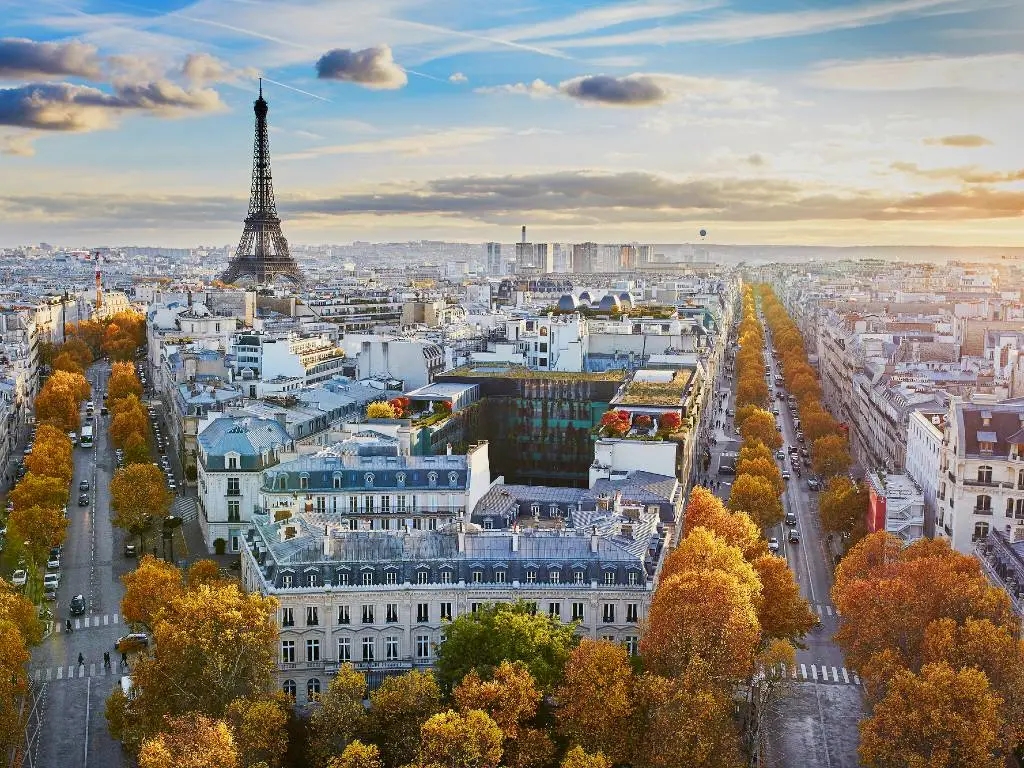
Paris: The French Capital Known As the Most Romantic City On Earth
Ah, Paris. Just the mention of it is enough to make many people go misty-eyed. An ancient city long known as an international hub for food, art, fashion, and culture, it’s above all cloaked in an aura of romance.
Though the reality might not match the idealized image (there’s even a disorder called Paris syndrome that describes the deep disappointment some first-time visitors suffer when the real thing doesn’t meet their expectations), it can’t be denied that Paris still has a certain magical feeling unlike anywhere else. With its graceful architecture, buzzing sidewalk cafes, lush green parks and gardens (more than 480 of them), chic boutiques, famed museums like the Louvre, and more than 40,000 restaurants, Paris has plenty to offer the 30 million+ visitors it attracts most years.
So, while it might not be quite the dreamy paradise it’s sometimes hyped up to be, a trip to Paris always has been, and remains, a good idea (even if the famous quote attributed to Audrey Hepburn actually comes from the 1995 remake of Sabrina.)

The city of love, light, and a dozen other names
As the most romantic (or romanticized) place on Earth, Paris is often referred to as the City of Love. Its most common nickname, though, is the City of Light (La Ville Lumière), attributable both to the major role Paris played as a center for new ideas during the 17th–18th centuries’ Age of Enlightenment (Le siècle des Lumières) and because in the 1820s it was one of the first cities in the world to be lit by gas street lamps.
But alternative names for Paris don’t end there. Locally it’s often referred to as Paname, a moniker said to originate from the stylish Panama hats that fashionable 19th-century Parisians wore. It’s also often nicknamed Lutèce, a reference to Lutetia, the city’s original name when it was first a Gallic settlement and later part of the Roman Empire.
As for the origins of its current, official name, it was called Paris beginning in the 4th century CE after the Parisii, the tribe of Gauls who first settled the area in around 250 BCE.
Mapping the city

Paris is divided into 20 subdivisions, called arrondissements (meaning “to round off” or “to make round”), which are arranged in a clockwise spiral, like the shape of a snail’s shell. The spiral starts from the 1st, which centers on the Louvre, and ends at the 20th, Ménilmontant, in northeastern Paris. Each arrondissement has a name in addition to a number and has its own separate administration, headquartered in a “mairie” (town hall) with an elected mayor.
In 2020, the first four arrondissements were, somewhat controversially, combined into a new arrondissement called Paris Centre and now share a single mayor. While their administrations have been consolidated, they continue to exist as separate entities in name and character.
The other major division of the city is into the Right Bank (Rive Droite) and Left Bank (Rive Gauche). The Right Bank describes all of Paris north of the river Seine, while the Left Bank is anything south of the river. Historically, the Right Bank was considered more sophisticated and refined, while the Left Bank was generally more bohemian, but these days those distinctions no longer have much meaning, with artsy, working-class, and high-end areas on both sides of the river.
Say it in Parisian
If you can dredge up some long-lost phrases from your high-school French class, Parisians will certainly appreciate the effort you put into your “bonjour” and “s’il vous plaît,” but if you really want to impress them, pop some local argot (slang) in there.
A particularly Parisian form of argot is verlan, a playful way of inverting the syllables in a word. The word verlan itself is an example because it’s an inversion of l’envers (reverse). Other commonly used verlan words include meuf (woman or chick, from the word femme), ouf (crazy, from fou), and chelou (meaning “weird” or “shady,” from louche).
To use the example words together: “Cette meuf est trop chelou. C’est un truc de ouf!” (“This chick is really shady. It’s crazy!”) Watch how quickly eyebrows fly up when you bust out these phrases the next time someone in Paris pegs you as a tourist.
When a simple baguette isn’t so simple

What’s the most Parisian baked good? A macaron? A croissant? If you pay attention to what locals are carrying as they stroll around the streets, you’ll quickly realize that it’s a baguette.
Parisians usually buy baguettes daily, or even twice a day—once in the morning and once in the evening. You’ll often see them being carried bare, or wrapped in a scrap of paper, fresh and still warm from the oven. You might even catch someone munching on the tip—le quignon—on the way home from the bakery. (Although eating while walking is generally frowned upon in Paris, baguette nibbling is an exception.)
If you want to try the best baguettes that Paris has to offer, don’t buy them in a supermarket. Look for a boulangerie, preferably one displaying a yellow-and-blue sign that indicates an artisan bakery—and with a line out front, which often indicates a neighborhood favorite.
Ask for une tradition to order a baguette de tradition (sometimes called a baguette à l’ancienne or baguette de campagne), which is higher quality and more flavorful than a baguette ordinaire. While an ordinary baguette could easily be mass-produced in a factory, a baguette de tradition must be handmade and baked on-site. If you prefer your baguette golden-brown with a crunchy crust, you can order it bien cuite and if you prefer it softer and paler, you can ask for it pas trop cuite. It’s also fine to order a demi-baguette (half a baguette).
The sandwich that’s more than the sum of its parts
And what would be the most Parisian sandwich? Hands-down a jambon-beurre (also known as le Parisien), a simple baguette sandwich spread with butter and filled with slices of local ham. Sometimes cornichon pickles are added as well, but the most classic version is as basic as its name: ham and butter.
As with all foods that simple, the quality of the ingredients is extremely important. This sandwich needs to be made with a crusty baguette de tradition, good jambon de Paris, and fresh French butter. While there are many places in Paris where you can pick up a jambon-beurre for your perfect pique-nique, some of the best spots include Caractère de Cochon near the Marché des Enfants Rouges in the Marais and CheZ Aline near Voltaire in the 11th arrondissement.
Life on the water

The Seine and its roughly 75 miles of connecting canals are the watery heart of Paris, adding to the atmosphere of romance and offering an alternative way to experience the city.
While sightseeing tours along the river are a well-known attraction, you can also rent small electric boats on the Canal de l’Ourcq for a self-guided tour or floating picnic.
For many years, the Seine has been infamous for its pollution levels (in fact, swimming in it had been banned since 1923), but there have recently been massive efforts to clean it up. A trio of floating swimming pools were opened to the public on the Bassin de la Villette in 2017 and the city hopes to host a swimming competition for the 2024 Olympics in the river itself.
For a deeper look at the history of the river and its role in the city’s development, check out the book The Seine: The River That Made Paris.
The Parisian art of protest
One of the more inconvenient facets of Parisian life you’re likely to encounter during a visit is a grève, or strike. They happen regularly and can cause massive disruptions when they involve airport, train, taxi, or public transportation workers, as they often do. In fact, the French rail system has had a strike every year since at least 1947 (when they started keeping track).
Usually, they’re limited to a day or two, but can sometimes drag on for weeks or even months. Locals are mostly used to the grèves and have learned to structure their lives around them, but when you’re visiting on a limited schedule, they can put a real damper on a vacation.
So why does it seem that the French are always on strike? The reasons are many and complex, but it has something to do with the country’s history of revolt, the structure of its unions, its electoral system, and public support for workers’ rights. Since they’re unlikely to disappear anytime soon, if you’re affected by one, the best you can do is be patient and say, “c’est la vie.”
Can-can you imagine?

The legendary Moulin Rouge cabaret lies at the foot of Montmartre hill in the notoriously somewhat-seedy Pigalle district. The giant red windmill on its roof recalls the days when Montmartre was a rustic and rural area covered in real windmills, used for grinding flour or spices or producing plaster of Paris from local gypsum deposits.
The famous cancan dance, considered scandalous when it first appeared, was popularized at the Moulin Rouge by stars like Jane Avril and La Goulue, both immortalized in posters painted by Toulouse-Lautrec.
One of the Moulin Rouge’s greatest (and highest-paid) early stars was Joseph Pujol, better known as Le Pétomane (“the fart maniac”), a maestro of the art of flatulence. He could play the French anthem, smoke a cigarette, and blow out candles, all just by passing gas. A single (and sadly, silent) film of “the fartiste” exists, shot by none other than Thomas Edison in 1900.
Good to know
How to budget for a trip to Paris
They say there’s no such thing as a free lunch, and that’s certainly true in Paris. French food is exquisite, which is reflected in the prices of just about everything from the Michelin-starred eateries to the quaint cafes serving time-honored recipes prepared with dozens of ingredients each. Up to $300/day is not an unreasonable budget for Paris, as a good hotel is $100-$150/night, and you could easily spend $100/day on food.
The good news? If you’ve bought a bottle of wine in Paris for more than $20, you’ve wasted your money. Great wine is amply available for $10-$12/bottle. Plus, heavenly pastries and simple ham-and-butter sandwiches cost only a few dollars.
Safety considerations
Paris is a pretty safe city to visit. Petty theft and pickpocketing are a real threat here, particularly for tourists, but diversity and inclusion are pillars of Paris, so while you might fall victim to a sleight of hand if you aren’t careful, you can relax knowing that Paris is welcoming for all, including Black and LGBTQIA+ travelers. Solo women will also feel at home, though there are of course pockets of the city that might seem a bit dodgy late at night. Stick to the hip neighborhoods and you’ll be fine.
Weather in Paris
On paper, Paris weather is pretty temperate all year round. Summer average highs range from 74-78°F. In practice, however, summer can be a lot hotter, especially in July and August when heat waves can push temps well above 90°F.
Winter in Paris is also, technically, pretty temperate with average highs ranging from 46-48°F and dipping into the high 30s at night. While grey days and rain can make it feel a bit colder, snow is a very rare occurrence.
When to visit Paris
April-early June and September-October are the ideal time to visit. Crowds are fewer than in peak summer, costs are lower, and the weather is generally lovely. Summer can be hot and sticky (though it’s fun to cool off at beaches and swimming spots set on along the Seine river), and in August a lot of shops and restaurants close down as locals head out of the city for summer vacation. November through March can be cold and wet but the trade off is few lines, even at the most popular spots.
Money saving tips
Look for free days. Many museums, including the Louvre, are free or have reduced admission costs on certain days. The Louvre is free the first Sunday of each month from October to March. The Musée d’Orsay has reduced admission after 4:30, on Thursdays, and the first Sunday of each month.
Get the set menu. Restaurants often have a menu of the day or prix fixe menu that offers three courses for a reduced price. And it’s usually delicious.
Check out free activities. Lots of Paris’s best attractions are free, including the Musée d’Art Moderne, Maison de Victor Hugo, and the Jardin du Luxembourg.
Public transportation in Paris
The Paris Metro is a great way to get around the city; it’s reliable, fast, and covers quite a lot of (under)ground, with over 300 stations, though it offers little in the way of accessibility. Walking is also a fantastic mode of transit and the best way to experience the city at its fullest; you might say that like New York City, the metro and the sidewalks are typically your best bets for affordable, efficient travel. (Also like NYC, you most likely do not want to drive here.) Taxis and Ubers abound, too, so you’re never too far from your next destination no matter how you get there.
Paris airports
Paris has three major airports connected to the city, though one is much further from the city center than the other two.
Paris Charles de Gaulle Airport (CDG) is the primary airport serving Paris, the biggest international airport in the country, and one of the busiest in Europe. It’s about 14 miles from the city center and the main hub for Air France. It’s also a focus city for EasyJet, Vueling, and Air France Hop.
Paris Orly Airport (ORY) is a bit closer to central Paris at just over eight miles away. It’s now a secondary Paris airport, though it was the city’s main airport until the mid-1970s when Charles de Gaulle Airport opened. Orly is also a hub for Air France, as well as a focus city for a number of budget carriers—including EasyJet Europe, Transavia France, Vueling, Twinjet, and Air France Hop.
Beauvais-Tillé Airport (BVA) is the third international airport that serves Paris, and it’s favored mainly by budget airlines. Although it’s often called Paris-Beauvais Airport, it’s nearly 55 miles away from Paris. Beauvais is Ryanair’s Paris airport, and it’s also served by Wizz Air and Blue Air among other low-cost carriers.
How to get to Paris from Charles de Gaulle Airport (CDG)
De Gaulle Airport is connected to central Paris via the RER B train line. Ticket prices cost about €12 and the trips to Gare du Nord, Châtelet-Les-Halles, or Denfert-Rochereau stations take between 25–35 minutes. RoissyBus operates a nonstop coach from CDG to the Paris-Opéra for about €14 and a travel time of about an hour. There’s a fixed rate for taxi transfers into the city (€53 for the right bank and €58 for the left bank) and rideshare options are Uber and Bolt. Expect rideshare fares to be at least €35.
How to get to Paris from Orly Airport (ORY)
Orly is connected to Paris on the RER B train line, just like De Gaulle Airport—the difference being travelers must take the OrlyVal shuttle from the airport terminal to the RER B station at Antony. The total cost is a little over €12 and the combined travel time to Gare du Nord, Châtelet-Les-Halles, or Denfert-Rochereau stations is 25–35 minutes. Paris RATP city buses operate a line between the airport and Denfert Rochereau station in about 30 minutes at a cost of under €10. The fixed taxi fare between Orly and Paris is €32 for the left bank and €37 for the right bank, and rideshare options are Uber and Bolt with fares starting in the €25-30 range.
How to get to Paris from Beauvais-Tillé Airport (BVA)
The most straightforward and cost-effective way to get from Beauvais Airport into Paris is with the Paris–Beauvais Shuttle. A one-way ticket is about €16 and the trip takes 75 minutes.
Join Going to find cheap flights to Paris and around the world.
Read about more destinations in France:
Published October 18, 2023
Last updated February 15, 2024
Articles you might like
View AllTreat your travel to cheap flights
Most deals are 40-90% off normal prices with great itineraries from the best airlines. If it's not an amazing deal, we won't send it. Sign up for free to start getting flight alerts.




